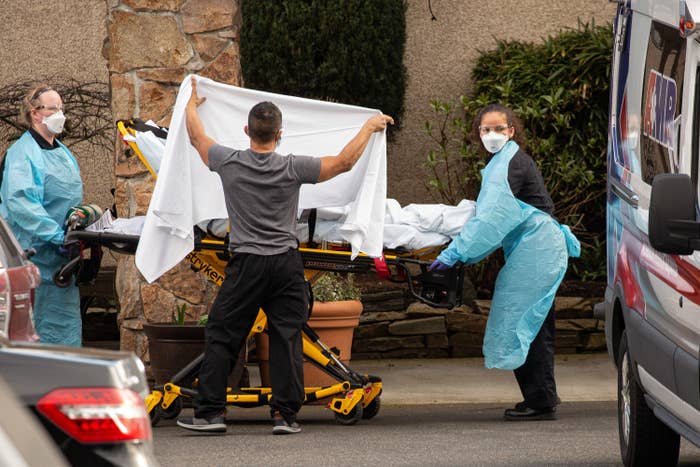
As the coronavirus touches down in the US, Washington state has so far been the hardest-hit, with at least 27 confirmed cases, including nine deaths, as of Tuesday.
Many more are likely to follow. If a new genetic analysis is to be believed, the virus has been circulating — undetected — throughout the state for weeks.
Preliminary analysis of a pair of cases, conducted late last week by the Fred Hutchinson Cancer Research Center in Seattle, supports the increasing likelihood that some people are now becoming infected within the US, as opposed to while abroad or from a known case.
The findings also underscore how badly diagnostic testing has lagged nationwide, allowing the pathogen to spread in American communities largely undetected. In the latest sign of just how unclear the scope of the outbreak is, the earliest known death in the US occurred in the Seattle area last week, but its connection to the coronavirus was not reported until Tuesday afternoon.
Caitlin Rivers, an epidemiologist at the Johns Hopkins Center for Health Security, said that what is happening in the Seattle area may be happening elsewhere, too. California has reported at least four cases spread by community transmission. There were more than 100 cases across the US as of Tuesday.
“We should be thinking of this as our first warning, or an early warning, that we are starting to see a new chapter in the US outbreak,” Rivers told BuzzFeed News.
And Columbia University virologist Angela Rasmussen said by email, “This indicates that there are likely foci of community spread in other states, which means that it is going to be a lot harder, if not impossible, to contain this virus.”
On Saturday, Trevor Bedford, a scientist at Fred Hutchinson, revealed that his team had sequenced the genomes of two coronavirus cases in Washington. One of them, reported Jan. 19, was the first case in the US: a man who had recently traveled back from Wuhan, China, the epicenter of the virus, to Snohomish County, Washington.
The second, reported last Friday, was that of a high school student, who was also in Snohomish County but had not traveled to a country affected by the outbreak, according to local public health officials.
Bedford said on Twitter that the second case turned out to be genetically similar to the first, with the two sharing a rare variant that made the similarity highly unlikely to be a coincidence. More likely was that the first infection had spread in the community before spawning the second.
@seattleflustudy This case, WA2, is on a branch in the evolutionary tree that descends directly from WA1, the first reported case in the USA sampled Jan 19, also from Snohomish County, viewable here: https://t.co/gxyo0PsJ7x 2/9
“This strongly suggests that there has been cryptic transmission in Washington State for the past 6 weeks,” he wrote, adding that he believed the state was facing an “already substantial outbreak.” His initial models projected that the number of infections in the state was likely around “a few hundred,” and a blog post including updated case counts on Monday estimated that it was closer to 600. Bedford wrote that this matched his projections of the number of infections in Wuhan on January 1.
Outside experts stressed that the models, based on the small amount of data currently available, were preliminary. Bedford was not available for further comment.
Washington Gov. Jay Inslee declared a state of emergency over the weekend. The nine deaths due to coronavirus in the state included elderly residents of the Life Care Center nursing facility in Kirkland.
Jamie Nixon, a spokesperson for the state’s Department of Health, said that the agency was evaluating the Fred Hutchinson team’s findings. “It is definitely possible that COVID-19 has been circulating, with people experiencing mild symptoms just like the flu,” Nixon said by email.
Only now are those cases starting to be caught, in Washington and elsewhere.
The Centers for Disease Control and Prevention has been widely accused of failing to make testing broadly available during the initial, crucial weeks when the disease entered the US. Critics blame the agency for shipping hundreds of faulty diagnostic test kits to local and state laboratories and imposing strict criteria on who could be tested.
The CDC widened the criteria last week, and has said it's come up with a fix for its original test, tossing out a defective part of the DNA test. On Tuesday, the agency said it would be sending out 75,000 tests to labs across the country by the end of the week. And the head of the FDA said that total will come closer to 1 million with tests from commercial providers. But only about 500 Americans had been tested as of Sunday, and many scientists believe these efforts are too late.
“Everyone in public health has asked for more testing for like a month now,” said Tara Smith, an epidemiologist at Kent State University. “We’ve been slow to roll that out, and that’s a big problem.”
As the tests roll out, a spike in cases will likely mean that more existing infections are being confirmed, not necessarily that new infections are happening.
“It’s not like we’re having some crazy explosion in the next few days,” Rivers said. “We’re just catching up to understand the current picture. The early numbers might feel alarming, but you have to interpret them knowing that we’re now just getting visibility on things that have already been happening.”
Azeen Ghorayshi contributed reporting to this story.
UPDATE
This story has been updated to include more information about Trevor Bedford's projected number of cases in the Washington coronavirus outbreak.
UPDATE
This story has been updated to include coronavirus case counts in Washington as of Tuesday afternoon.
UPDATE
This story has been updated to include more up-to-date numbers about coronavirus cases spread through community transmission in California.
